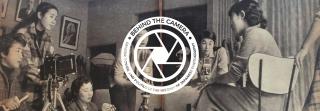-
Background:
Supported by the ARC-iJAC, the research led by Dr. Ewa Machotka and Dr. John Pavlopoulos (Stockholm University) has pursued the large-scale digital geospatial exploration of places depicted in Japanese early modern ukiyo-e landscape prints through Natural Language Processing (FY 2021). Their follow-up project aims to apply NLP technology to inscriptions on ukiyo-e landscape prints to facilitate a large-scale exploration of textual information featured in those prints (FY 2023).
Project leader: Dr. Ewa Machotka (Dept. of Asian and Middle Eastern Studies, Stockholm University)
Project manager: Dr. John Pavlopoulos (Dept. of Computer and Systems Sciences, Stockholm University)
Project members: Konstantina Liagkou, Panagiotis Papapetrou, Marita ChatzipanagiotouThank you very much for your time today. Could you please tell us the motivation for your ARC-iJAC research project Natural Language Processing for a Geospatial Exploration of Japanese Ukiyo-e Prints?
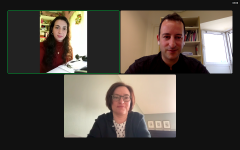 Machotka: The last several decades saw the rise of interest in the concept of Global Art History, understood as a heterogenous transnational and critical study of the world's cultural production. One of the challenges of this new research direction is the question of how to acknowledge the conceptual and material heterogeneity of artistic production across the world in a way that does not support a universalist understanding of cultures. This concern prompted our research. We saw that Japanese early modern landscape prints, as globally recognizable non-Western pre-modern artifacts, offer a critical testbed for considering these issues.
Machotka: The last several decades saw the rise of interest in the concept of Global Art History, understood as a heterogenous transnational and critical study of the world's cultural production. One of the challenges of this new research direction is the question of how to acknowledge the conceptual and material heterogeneity of artistic production across the world in a way that does not support a universalist understanding of cultures. This concern prompted our research. We saw that Japanese early modern landscape prints, as globally recognizable non-Western pre-modern artifacts, offer a critical testbed for considering these issues.Background:
Kelly Midori McCormick is an assistant professor of Japanese history at the University of British Columbia, Vancouver, specializing in the history of the material and visual culture of modern Japan.
Carrie Cushman is the Edith Dale Monson Gallery Director and Curator at the Hartford Art School. She holds a Ph.D. in Art History from Columbia University and is a specialist in postwar and contemporary art and photography from Japan.
Supported by the ARC-iJAC, their project team has created and launched the bilingual website Behind the Camera--part database, part educational tool--spotlighting a diverse range of international experts on the history of Japanese photography from the perspective of gender and power.Thank you very much for your time today. Could you please tell us about your motivation to start your FY 2021 ARC-iJAC project Expanding the Study of Japanese Photography and Gender: Modules for Teaching and Public Access?
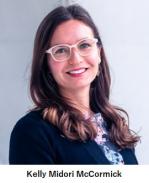 Prof. McCormick / Prof. Cushman: Conceived in 2017, Behind the Camera was established to address the lack of scholarship and access to primary sources on the histories of Japanese women in photography. The idea for Behind the Camera was sparked with a simple question: what resources existed on the roles that women have played in the history of Japanese photography?
Prof. McCormick / Prof. Cushman: Conceived in 2017, Behind the Camera was established to address the lack of scholarship and access to primary sources on the histories of Japanese women in photography. The idea for Behind the Camera was sparked with a simple question: what resources existed on the roles that women have played in the history of Japanese photography?Since the introduction of the first camera to Japan in 1848, women have been integral to the social constructions of photography as a visual technology, art form, and commercial practice.
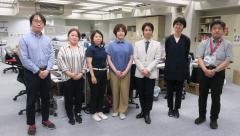 Murakami san, thank you very much for your time today. Would you please tell us about your time at the Art Research Center (ARC)?
Murakami san, thank you very much for your time today. Would you please tell us about your time at the Art Research Center (ARC)?Murakami: I have very fond memories of the ARC. During my graduate studies at Ritsumeikan University, I could obtain a variety of experiences through my classes, writing my master's thesis, and the internship opportunities in Japan and abroad provided by the ARC.
Within the well-established research environment of the ARC, I could immediately put the knowledge I had obtained in the classroom on digital archiving into practice, the most memorable of which was the filming of the Katayama family's Noh play that I was lucky to participate in.*
Background:
Professor Hans Bjarne Thomsen has held the Chair for East Asian Art History at the Institute of Art History, University of Zurich, since 2007. His publications include Japanese Woodblock Prints from the Ernst Grosse Collection (2019). Supported by the International Joint Digital Archiving Center for Japanese Art and Culture (ARC-iJAC), Art Research Center, Prof. Thomsen conducted his research project 'Tracing the Reception of Japanese Art in the West: Case Study of Freiburg im Breisgau' in FY 2021, followed by the project 'Tracing the Reception of Japanese Art in the West: The Case of Monte Verità' in FY 2022.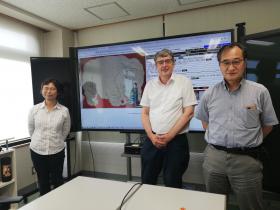 Professor Thomsen, thank you very much for your time today. How did you first connect with the Art Research Center (ARC)?
Professor Thomsen, thank you very much for your time today. How did you first connect with the Art Research Center (ARC)?Prof. Thomsen: I met Professor Akama in Geneva more than a decade ago. Since then, we have embarked on several projects digitizing and cataloging Japanese woodblock prints at the Print Cabinet in Geneva.
Thanks to the efforts of the ARC in digital archiving of these prints, we have held two exhibitions at the Print Cabinet--one on kabuki prints in 2014 and the other on surimono prints that is currently ongoing.
In 2016, the University of Zurich also held a three-day international symposium on katagami in Zurich where several ARC faculty members presented their research.
[イベント情報]2022年4月11日(月)Background:
Dr. Mohamed Soliman is an Egyptian archaeologist and the Director of the Advanced Studies Unit for Cultural Heritage at the National Research Institute of Astronomy and Geophysics (NRIAG) in Cairo. While completing his two-year JSPS Postdoctoral Research Fellowship at Ritsumeikan University's Institute of Disaster Mitigation for Urban Cultural Heritage (DMUCH), Dr. Soliman started his research project "Qait'bay Citadel (1477-1479): Visualizing the Main Coastal Fortification of Medieval Alexandria, Egypt" in FY 2021 supported by the ARC-iJAC.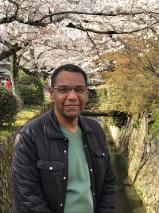 Dr. Soliman, thank you very much for this interview. How was your time here in Japan?
Dr. Soliman, thank you very much for this interview. How was your time here in Japan?Dr. Soliman: Thank you. Although the pandemic hit us soon after my arrival, and I had to adapt my research plans, I had a rewarding time in Japan. The field of cultural heritage studies, in particular, relies a lot on field data acquisition, so working from home is difficult.
However, I received a lot of guidance from my host professor Keiji Yano* to achieve my research goals, conduct joint research and expand my network within the Japanese research community.
*Professor Keiji Yano (College of Letters, Ritsumeikan University) is a Deputy Director of the Art Research Center.
Could you please tell us why you started the project of visualizing Qait'bay Fort?
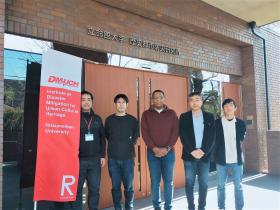
Dr. Soliman: Qait'bay Fort, built in the 15th century, is not only considered one of the most significant fortifications in Egypt but along the Mediterranean Sea.
The Fort stands on the same site as the legendary Pharos Lighthouse. However, it is exposed to natural and man-made disasters such as seismic hazards and tsunamis due to this location.
The fire disaster at Notre Dame Cathedral in Paris in 2019 reminded us of the importance of 3D visualization to preserve and document cultural heritages at risk and make our research outcomes available to scholars and the public alike.
At the same time, the project contributes to the sustainability goals of our local tourism industry, reflected in the Sustainable Development Strategy (SDS): Egypt Vision 2030.
Furthermore, we consider this a prototype project to build bridges of scientific collaboration between Ritsumeikan University, E-JUST** and NRIAG.
**Egypt-Japan University of Science and Technology (E-JUST)
続きを読む>>[イベント情報]2022年1月24日(月)Background:
Dr. Ryoko Matsuba, a specialist in Edo period print culture, received her Ph.D. from Ritsumeikan University in 2008. She is now Lecturer in Japanese Digital Arts and Humanities at the Sainsbury Institute for the Study of Japanese Arts and Cultures (SISJAC), University of East Anglia. Before taking up that post, she participated, as a member of curatorial staff, in two major exhibitions at the British Museum: Hokusai Beyond the Great Wave (2017); and the Citi Exhibition Manga (2019). She co-authored the exhibition catalogue for the latter.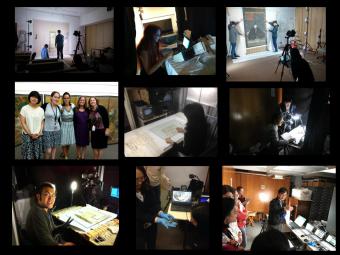 Matsuba sensei, thank you very much for joining us today. Would you tell us about your time at the ARC?
Matsuba sensei, thank you very much for joining us today. Would you tell us about your time at the ARC?Dr. Matsuba: When the Art Research Center was established, I was an undergraduate student at Ritsumeikan University. I joined the digital-archiving project led by Professor Akama as a part timer involved digitizing kabuki playbills from Osaka and Edo dating from the 18th and 19th centuries.
I gradually came to grasp the techniques and basic procedures of digital archiving, such as scanning photographs, cataloging, and improving the searchability of items, while I worked through the kabuki playbills. This experience laid the foundation for my M.A. and Ph.D. research topics. So, I treasure my time at the ARC very much.
We are glad to hear this. How did it come about that you started to work in the UK?
Dr. Matsuba: When I was still a graduate student, the ARC first provided me with the opportunity to travel to the UK and work at the British Museum as part of the team preparing the exhibition Kabuki Heroes on the Osaka Stage 1780-1830 (2005).
The ARC has been digitizing Japanese collections in renowned museums around the world, and supporting them in creating exhibitions. These activities offer many hands-on training and networking opportunities for young researchers.
Subsequently, I participated in the preparation other British Museum exhibitions such as Shunga: Sex and Pleasure in Japanese Art (2013); Hokusai: Beyond the Great Wave (2017); and the Citi Exhibition Manga (2019). In addition, I contributed to and assisted in editing the exhibition catalogs for those exhibitions.
続きを読む>>[イベント情報]2021年9月21日(火)Project Overview:
At the center of this project, which involved Bachelor and Master students of Japanology at Goethe University Frankfurt, was the On Edo ezu (御江戸絵図) from the ARC database 'Maps of Japan from the Collection of Sir Hugh and Lady Cortazzi'.
Drawing on maps, guidebooks, and colored woodblock prints, this project attempted to correlate various sources of both geographical and visual experience and knowledge to hypothetically reconstruct how they might have shaped the late Edo period consumer's consciousness based on the materials accessible to them.
→ Click here to access the project website. Professor Kinski, thank you very much for your time. As the leader of the FY2020 ARC-iJAC project 'Edo Period Map goes Digital - The On Edo ezu as an Interactive Resource', could you tell us about your motivation to start this project?
Professor Kinski, thank you very much for your time. As the leader of the FY2020 ARC-iJAC project 'Edo Period Map goes Digital - The On Edo ezu as an Interactive Resource', could you tell us about your motivation to start this project?Prof. Kinski: I began to develop a strong interest in Digital Humanities (DH) in 2012 when I saw a presentation by Bettina Gramlich-Oka--a colleague at Sophia University--about creating an interactive biographic database as part of her interest in social network analysis.
Striving to incorporate text mining, topic modeling, or semantic network analysis in my approach to Edo period intellectual history, I have been making efforts to raise the interest amongst students in the approaches towards Japanese sources derived from DH.
Frankfurt University owns a small collection of printed books covering the period between 1650 and 1850, our 'Edo bunko' which we use for exercises in the classroom to decipher and transcribe larger quantities of text.
A talented student of mine, Koray Birenheide, created a program called 'DemiScript' that allows us to work with source material--whether premodern, modern, textual or visual--and to present the results of our transcription efforts. A far more advanced tool than expected, I was convinced it could serve as a platform for a larger, more ambitious classroom project.
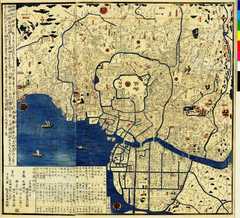
The ARC-iJAC provided a timely opportunity to put our plan into action by drawing on the materials in the ARC databases and combining the first-hand exploration of primary sources with concerns from urban infrastructure history and art history.
続きを読む>>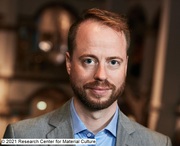 Dr. Kok, thank you very much for your time today. As Curator East Asia, you have been at the forefront of this joint research project with the ARC to digitize the extensive Japanese art collection of Wereldmuseum Leiden, part of the National Museum of World Cultures (NMVW).
Dr. Kok, thank you very much for your time today. As Curator East Asia, you have been at the forefront of this joint research project with the ARC to digitize the extensive Japanese art collection of Wereldmuseum Leiden, part of the National Museum of World Cultures (NMVW).What sparked your interest in Japanese art and culture?
Dr. Kok: In high school, I once received a book about Japanese design. It raised my interest to apply at a design academy. Not admitted on my first attempt, I began to study Japanese and enjoyed it so much that I never stopped.
During my studies at Leiden University, I became particularly fond of the kyōka surimono of the 1820s.
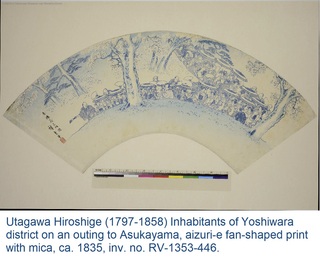
How do you feel about the overall collaboration with the ARC?
Dr. Kok: I am very thankful for our collaboration. The first contact between our museum and the ARC was already established more than ten years ago. During Professor Akama's visits, we would conduct photography together using the 'portable travel kit' he developed to digitize art collections abroad.
The execution of our joint project has never been stagnant, but you can see a continuous improvement year after year. It has also been a valuable learning experience for me to see the mechanisms Professor Akama uses to increase the quality of digitizing artworks.
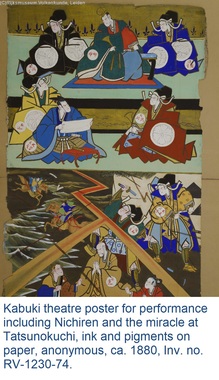
What is the significance of constructing and releasing this database in the ARC Virtual Institute?
Dr. Kok: We need to ensure comprehensive access for researchers to our collection.
Now that we have constructed and interlinked the ARC database with our museum database, the availability of our collection of printed materials to a Japanese-speaking audience is of great significance.
Furthermore, we appreciate the ARC's digital infrastructure for not only searching but also editing the database. The interactivity of the ARC database allows Japanese-speaking researchers to contribute to the database, paving the way for future research.
While our museum database is a more general database for a wide range of objects, the ARC database has a high level of specialization to cater to the specific needs of research in Japanese art and culture, such as ukiyo-e prints and early Japanese books.
続きを読む>>Background:
Kuzushiji is a kind of Japanese cursive script found in early Japanese books (until the mid-Meiji Period).
Due to the different writing styles compared with modern Japanese characters, kuzushiji can be understood only by a minority of trained specialists.
The Art Research Center (ARC), Ritsumeikan University, has developed an educational transcription system with an AI-enabled deciphering support function for kuzushiji to facilitate access to early Japanese books for academic research.
The training course started on May 14, 2021, and has counted participants from 12 countries so far. It is provided free of charge. (→Click here for details on the training course.)Professor Akama, thank you very much for your time today. You have just completed Phase 1 of the kuzushiji training course for beginners and intermediate levels. What is the purpose of your training course?
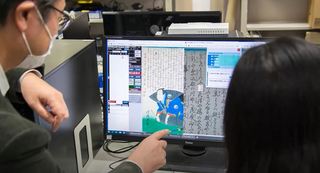 Prof. Akama: We have developed an AI-enabled transcription support system for kuzushiji specifically for educational purposes as part of an industry-academia collaboration with Toppan Printing Co., Ltd. The company kindly provided us with the API (application programming interface) of their kuzushiji recognition system that is powered by deep learning.
Prof. Akama: We have developed an AI-enabled transcription support system for kuzushiji specifically for educational purposes as part of an industry-academia collaboration with Toppan Printing Co., Ltd. The company kindly provided us with the API (application programming interface) of their kuzushiji recognition system that is powered by deep learning.Our purpose is to teach and support students and researchers in utilizing our transcription support system for their academic research projects based on the abundant materials available in the ARC's Early Japanese Books Portal Database. You can freely choose the materials you wish to transcribe from our database--with over 218,000 titles, one of the largest databases of digital-archived early Japanese books in the world.
I have held several workshops on the system, for instance, at the University of Leiden and the University of California, Berkeley. Not able to travel due to the pandemic, I hope to promote the system's usage by offering this online training course.
続きを読む>>[イベント情報]2021年4月14日(水)Professor Gerstle, thank you for your time today.
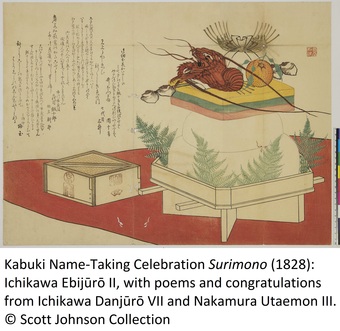
As the leader of the FY2020 ARC-iJAC project "Cultural Salons and the Visual Arts in Kyoto and Osaka, 1750-1900: Digitizing Kamigata Surimono and Paintings", could you please tell us the reason why you started this project?
Prof. Gerstle: I have been fascinated over the years by discovering how common it was in the Edo period for men and women of all ages and statuses to be active in cultural pursuits (遊芸) for pleasure.
I first realized this in researching gidayū amateur performance, where I found that until World War II gidayū as a hobby was popular all over Japan. I then saw how kabuki actors circulated among patrons and fans via haikai gatherings. Pursuit of the arts also importantly was a way for women as well to socialize outside their neighbourhood, and for individuals of different status (身分) to interact.
I still find it intriguing that individuals often had several pen names for their different activities. Under a pen name, everyone was nominally equal as a devotee of the particular art they were participating in. In contemporary Japan, we still see that it is common to socialize through cultural or other organized activities, like the clubs at university.
続きを読む>>


